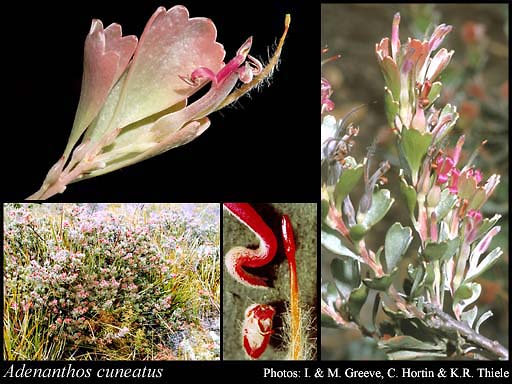- Reference
- Nov.Holl.Pl. 1:28 (1805)
- Conservation Code
- Not threatened
- Naturalised Status
- Native to Western Australia
- Name Status
- Current
Erect or spreading, lignotuberous shrub, 0.3-3(-5) m high. Fl. red/pink, Jan to Dec (mainly Aug-Nov). White, grey or yellow sand. Coastal sand dunes, sandplains.







Scientific Description
Shrubs or prostrate shrubs, 0.5-5 m high. Leaves alternate, 15-30 mm long, 10-15 mm wide, glabrous; lamina flat, clearly widest above the middle, divided only at the apex, entire or shallowly divided, with glands at the leaf (or leaf lobe) apex or on the surface of the leaf blade. Inflorescences red; innermost bracts 2.5-3 mm long; peduncles 8-11 mm long. Perianth 24-26 mm long, glabrous or hairy; ovary glabrous; pistil 30-35 mm long, pollen presenter erect, style hairy. Flowers in January, February, March, April, May, June, July, August, September, October, November or December. Occurs in the Eremaean (ER) or South-west (SW) Botanical Province(s), in the Avon Wheatbelt (AW), Jarrah Forest (JF), Mallee (MAL), Warren (WAR) or Esperance Plains (ESP) IBRA subregion(s).
Distribution
- IBRA Regions
- Avon Wheatbelt, Esperance Plains, Hampton, Jarrah Forest, Mallee, Swan Coastal Plain, Warren.
- IBRA Subregions
- Eastern Mallee, Fitzgerald, Hampton, Katanning, Perth, Recherche, Southern Jarrah Forest, Warren, Western Mallee.
- IMCRA Regions
- Eucla, WA South Coast.
- Local Government Areas (LGAs)
- Albany, Cranbrook, Denmark, Dundas, Esperance, Gnowangerup, Jerramungup, Kent, Lake Grace, Manjimup, Plantagenet, Ravensthorpe, South Perth.